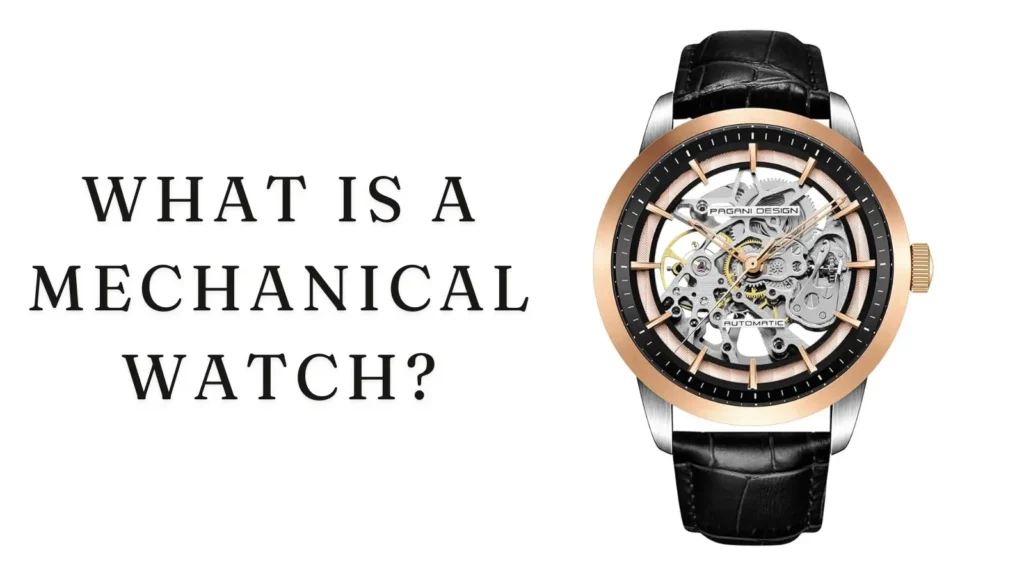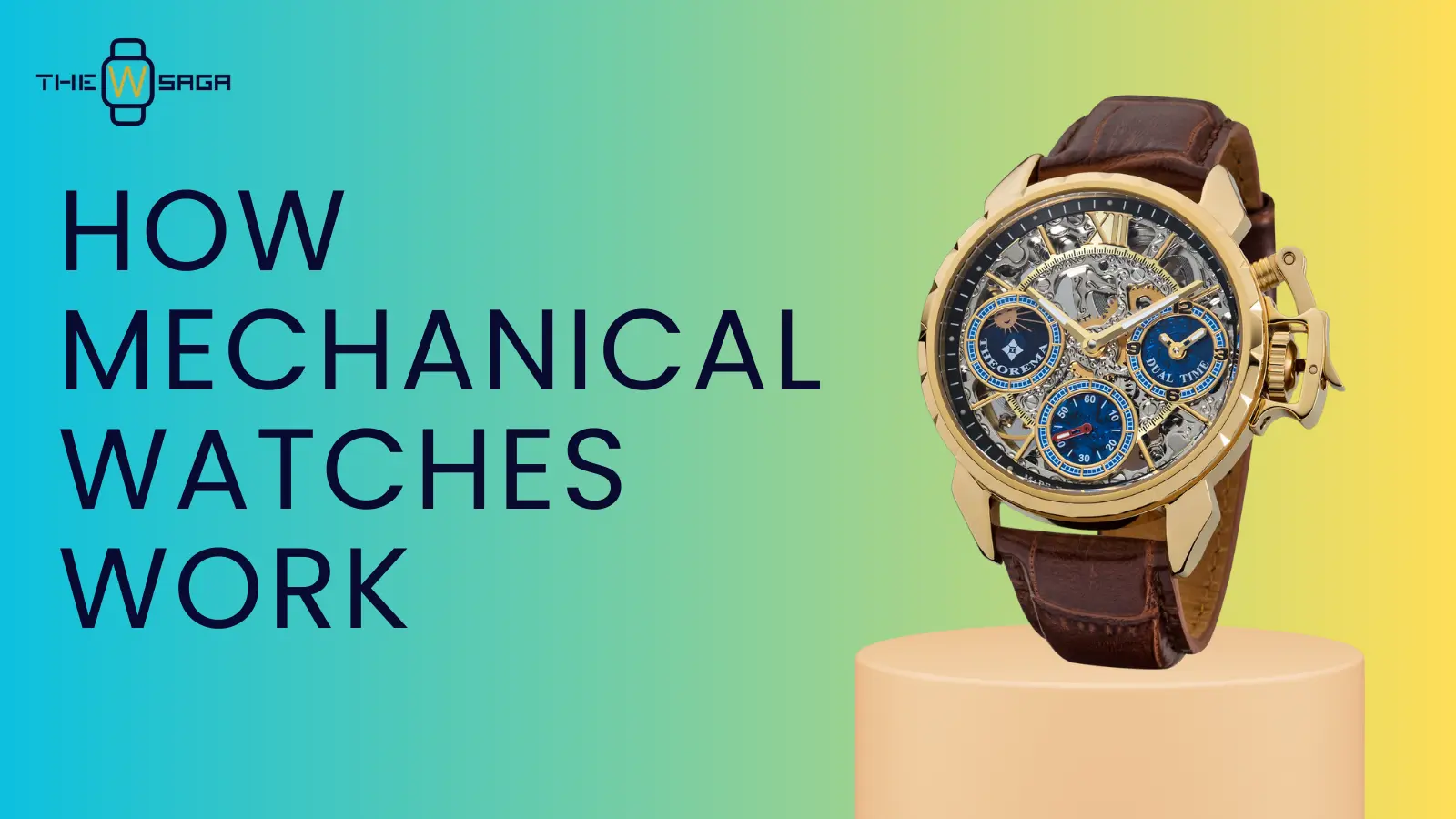Table of Contents
Mechanical watches take on a different personality in the current age of digital dominance. The elegant, complex gearwork of these timekeeping pieces evokes the very best in craftsmanship and is a testament to both beauty and functional success. Mechanical watches, to be exact, and what are they exactly that makes them captivate collectors and enthusiasts alike?
What is a Mechanical Watch?

A mechanical watch is a timepiece powered by a complex system of gears, springs, and levers without the need for batteries or electronics. It operates by winding a mainspring, which stores energy that is gradually released through a series of gears to move the watch’s hands. Mechanical watches are admired for their intricate craftsmanship, durability, and timeless appeal, making them a blend of precision engineering and artistry.
Key Components of Mechanical Watch
- Mainspring: The energy source that powers the watch.
- Gear Train: Transmits energy from the mainspring to the hands.
- Escapement: Regulates the release of energy to ensure accurate timekeeping.
- Balance Wheel: oscillates to control the passage of time.
How Mechanical Watches Work
The principle upon which mechanical watches function is rather captivating. When you wind the watch, it tightens the mainspring, which stores all this potential energy. A gear train transfers power to the escapement, which slowly releases this energy. The escapement regulates the flow of energy by periodically allowing release in consistent duration intervals so that the balance wheel can oscillate. These oscillations are what power the hands of your watch.
Types of Mechanical Watches
Mechanical watches are generally divided into two main types: Manual Mechanical Watches and Automatic Mechanical Watches. Each type operates based on similar principles but differs in the way energy is provided to the watch.
Manual Mechanical Watches
Hand-wound watches, another name for manual mechanical watches, are the most classic type of watch. Manual winding watches need the person wearing them to manually turn up the crown once in a while to keep its mainspring under tension. The energy can be kept between watches to ensure the watch continues running, keeping time.
Automatic Mechanical Watches
The automatic mechanical features, also known as self-winding, offer a more contemporary approach to breathing life into your watch. These watches use the movement of a wearer’s wrist to spin a rotor inside the watch instead of manually winding it. While spinning, it winds the mainspring, which provides energy to keep the watch in motion.
Features of Mechanical Watches
Mechanical Movement
- No battery: Unlike quartz timepieces, mechanical watches derive their energy from a tightly wound mainspring rather than a replaceable battery cell.
- Manual Winding or Automatic:
- Manual winding requires the user to wind the crown to tighten the mainspring.
- Automatic winding uses the motion of the wearer’s wrist to wind the mainspring via a rotor.
Mainspring
The mainspring is a coiled spring that stores mechanical energy. As it unwinds, it releases energy to power the movement of the watch’s gears and hands.
- The balance wheel functions like a pendulum, regulating the timekeeping of the watch.
- The escapement controls the release of energy from the mainspring, allowing the gear train to move incrementally, which moves the hands of the watch smoothly or in small steps.
Gear Train
- A series of gears transfers energy from the mainspring to the hands of the watch. The gear ratio determines how quickly the watch’s hands move.
Sweep Second Hand
- Most mechanical watches feature a sweeping secondhand rather than the ticking motion seen in quartz watches. It moves smoothly because the escapement regulates the release of energy in a continuous, controlled manner.
Precision Craftsmanship
- Mechanical watches are highly intricate, with numerous small components working together. Each piece is hand-assembled or finely crafted using precision machinery.
Power Reserve
- Mechanical watches have a limited power reserve, which refers to how long the watch can run without being rewound or worn. Power reserves typically range from 40 hours to several days.
Longevity
- With proper maintenance, mechanical watches can last for decades or even generations. They are seen as timeless pieces due to their durability and the tradition behind their design.
Aesthetic & Luxury Appeal
- Mechanical watches are often associated with luxury and craftsmanship. The intricate workings can often be viewed through a transparent case back, showcasing the movement in action.
Hand-Assembled
- Many high-end mechanical watches are hand-assembled by skilled watchmakers, further enhancing their appeal and exclusivity.
Conclusion
Mechanical watches differ from quartz based on the mechanism that drives them. They utilize a well-thought-out and intricate construction of gears, springs, and balance wheels. Therefore, when some event happens on the watch dial, all subsequent actions happen as a result of movement by the gear train. Another big difference between mechanical and quartz watches is the opportunity to see the whole chainwork inside; mechanical watches are usually made with sapphire glass back covers so that an owner has a chance to observe the beauty of creation. Fewer and fewer watches nowadays have this back cover because of an increasing interest in automatic quartz watches.

